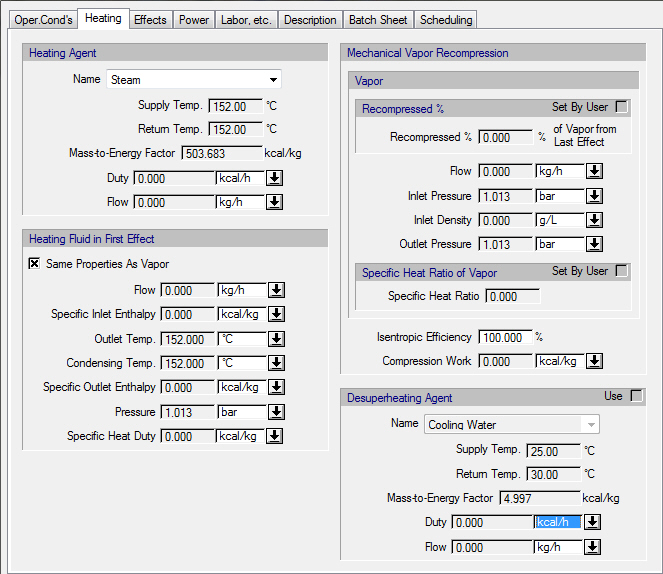

This tab appears on the interface dialog of the Continuous Multi-Effect Evaporation operation if the Vapor Recompression Option is set to “Mechanical Vapor Recompression” in the Oper. Conds Tab (see Multi-Effect Evaporation: Oper. Conds Tab).
The following table shows a brief description of the variables appearing in this tab; for a detailed description of these variables, see Multi-Effect Evaporation: Description of Terms The table also displays their default values and their generally acceptable range. Note that due to how the variables are used in the modeling equations, the range of acceptable values may be further reduced; for more details, see Multi-Effect Evaporation: Modeling Assumptions & Constraints.
|
Variable |
Default Value |
Range |
|
|
||
|
○ Heating Agent Name |
Steam |
Any Heating Agent |
|
● Supply Temp. of Heating Agent (oC) |
152.0 |
Positive |
|
● Return Temp. of Heating Agent (oC) |
152.0 |
Positive |
|
● Mass-to-Energy Factor of Heating Agent (kcal/kg) |
503.683 |
Positive |
|
● Duty of Heating Agent (kcal/h) |
0.0 |
Positive |
|
● Flow of Heating Agent (kg/h) |
0.0 |
Positive |
|
○ Same Properties As Vapor? |
<Yes> |
Yes/No |
|
● Flow of Heating Fluid in First Effect (kg/h) |
0.0 |
Positive |
|
● Specific Inlet Enthalpy of Heating Fluid in First Effect (kcal/kg) |
0.0 |
Positive |
|
● Outlet Temp. of Heating Fluid in First Effect (oC) |
152.0 |
Positive |
|
◙ Condensing Temp. of Heating Fluid in First Effect (oC) |
152.0 |
[Supply Temp., Return Temp.] |
|
◙ Specific Outlet Enthalpy of Heating Fluid in First Effect (kcal/kg) |
0.0 |
Positive |
|
◙ Pressure of Heating Fluid in First Effect (bar) |
1.013 |
Positive |
|
● Specific Heat Duty of Heating Fluid in First Effect (kcal/kg) |
0.0 |
Positive |
|
○ Recompressed % Set By User? |
<No> |
Yes/No |
|
◙ Recompressed % (% of Vapor from Last Effect) |
0.0 |
[0,100) |
|
● Flow of Vapor in Compressor (kg/h) |
0.0 |
Positive |
|
● Inlet Pressure of Vapor in Compressor (bar) |
1.013 |
Positive |
|
● Inlet Density of Vapor in Compressor (g/L) |
0.0 |
Positive |
|
● Outlet Pressure of Vapor in Compressor (bar) |
1.013 |
Positive |
|
○ Specific Heat Ratio of Vapor in Compressor Set By User? |
No |
Yes/No |
|
◙ Specific Heat Ratio of Vapor in Compressor |
0.0 |
Positive |
|
○ Isentropic Efficiency of Compression (%) |
100.0 |
(0,100] |
|
● Compression Work (kcal/kg) |
0.0 |
Positive |
|
○ Use Desuperheating Agent? |
No |
Yes/No |
|
○ Desuperheating Agent Name |
Cooling Water |
Any Cooling Agent |
|
● Supply Temp. of Desuperheating Agent (oC) |
25.0 |
Positive |
|
● Return Temp. of Desuperheating Agent (oC) |
30.0 |
Positive |
|
● Mass-to-Energy Factor of Desuperheating Agent (kcal/kg) |
4.997 |
Positive |
|
● Duty of Desuperheating Agent (kcal/h) |
0.0 |
Positive |
|
● Flow of Desuperheating Agent (kg/h) |
0.0 |
Positive |
Symbol Key: ○ User-specified value (always input); ● Calculated value (always output); ◙ Sometimes input, sometimes output
The following list describes the available specification choices in this tab; for more details on how these are implemented, see Multi-Effect Evaporation: Modeling Calculations.
•If the option “Same Properties As Vapor” is checked...
You must specify the Specific Outlet Enthalpy and Pressure of the heating fluid in the first effect. If the option to “Use” a desuperheating agent is also checked, then you must also specify the Specific Heat Duty of that fluid.
•If the option “Same Properties As Vapor” is not checked...
The Specific Outlet Enthalpy and Pressure of the heating fluid in the first effect will be calculated by the program based on the assumption that the thermodynamic properties of the heating fluid in the first effect (which may consist of heating agent, desuperheating agent and recompressed vapor) are the same as those of recompressed vapor. If the option to “Use” a desuperheating agent is also checked, then the same thing will be done for the Specific Heat Duty of that fluid.
•If you check the option to ‘Use’ a desuperheating agent...
A desuperheating agent will be added to the mixture of recompressed vapor and heating agent before it enters the first effect in order to improve heat transfer in the first effect. If the flow of the heating agent is not zero, the outlet temperature of the desuperheating agent must be the same as that of the heating agent (since both agents exit from the same outlet).
•If you do not check the option to ‘Use’ a desuperheating agent...
No desuperheating agent will be used.